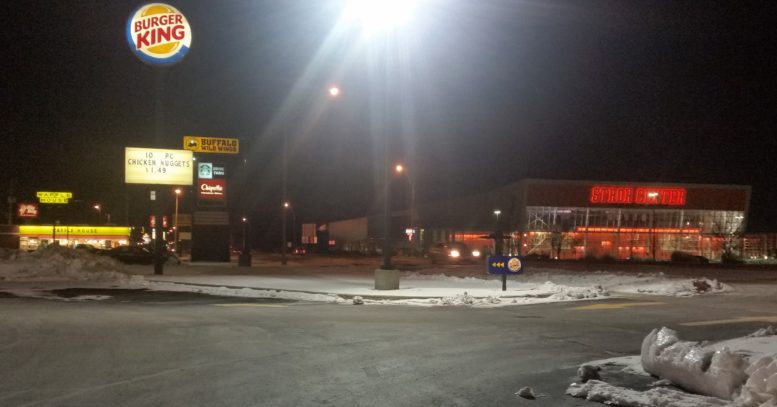By JAN LARSON McLAUGHLIN
BG Independent News
Motorists and pedestrians will be getting some relief on East Wooster Street with plans moving ahead for two roundabouts and two pedestrian crossings.
Bowling Green City Council voted unanimously Monday evening to work with ODOT on roundabouts at the I-75 intersections on Wooster Street and on two pedestrian beacons on East Wooster Street to help people cross the road near the Stroh Center and near McFall Center.
Though some who spoke at council are still skeptical of roundabouts, the traffic devices can reduce fatalities by more than 90 percent, cut injuries by 76 percent, and reduce all crashes by 35 percent, according to the Federal Highway Administration.
Those safety factors helped convince council to approve the plans.
While the roundabouts faced some concerns from local residents – the pedestrian crossings encountered no roadblocks.
The crossings will have buttons for pedestrians to push, which will activate red lights. Motorists will be required to stop, explained Bowling Green Public Works Director Brian Craft.
“They’ll no longer be running across five lanes,” Craft said about pedestrians trying to get across Wooster Street near the Stroh Center. They will no long be “hanging out in the middle of the street,” trying to make it to the other side.
ODOT is investing $368,000 in the pedestrian crosswalks, with officials hoping to study the crossings in high traffic areas. The lights, called pedestrian hybrid beacons, will make it much safer for walkers, Craft said.
ODOT is also sinking money into the roundabout project, committing $750,000 in safety funding, engineering and design.
Sandy Wiechman, of Wood County Safe Communities, offered data to “ease some of the concerns and fears of roundabouts.”
In 2013, Wooster Street between Mercer and Dunbridge roads saw 70 crashes, with 22 injuries. Based on the statistics from the Federal Highway Administration, the number of crashes could have been cut by 35 percent and the injuries suffered could have been cut by 76 percent.
“With the roundabouts, a lot of that would be reduced,” Wiechman said.
Roundabouts lead drivers to reduce their speeds, so any crashes that occur cause fewer injuries and less property damage.
Wiechman said Perrysburg Township officials also got “a lot of pushback” about the roundabout recently installed on Roachton Road and Ohio 199. But officials are pleased with the rotary. “It’s great,” she said.
Bowling Green resident Bud Henschen repeated some of his concerns that he voiced at the last city council meeting about roundabouts.
“I hear about how great they are,” Henschen said. But he just isn’t sold on the concept. He voiced concerns about the roundabouts slowing down traffic, on them being difficult to enter, and creating traffic jams.
After hearing the safety data, Henschen said he was still concerned about how the cost may affect his company. If the roundabouts were going to create a tax hike, and cause him to pay his employees more, then he was opposed.
“I don’t mind it, if you can fund it,” he said. “But if you want to come to the taxpayers and say it’s going to cost another quarter percent income tax,” then he was not in favor, he added.
Council member Bob McOmber eased Henschen’s mind.
“We’re not going to raise income taxes to pay for the roundabout,” McOmber said. The city plans to borrow money and pay it off over time.
Marc Schaller, of Bowling Green, also voiced some concerns about the roundabouts, asking about problems that might occur with having multiple rotaries in such close proximity.
Craft explained that a lot of design work is going into the project to help make smooth exits off I-75, with a free flowing right turn lane from southbound I-75. There will also be a 12-foot wide walkway for pedestrians over the bridge deck, and improved lighting, he said.
Wiechman also said allowances are made for larger commercial vehicles.
Rob Piasecki, a Bowling Green resident who coordinates commercial drivers, said roundabouts slow down traffic, but keep it moving. “Roundabouts are really good things, especially for truck drivers,” he said.
McOmber agreed that roundabouts may take a little getting used to for some motorists. “It can be a little daunting,” he said. But the safety statistics help sell the traffic design device. “The numbers are mind-boggling.”
Council member Sandy Rowland agreed that the safety factors were too big to pass up.
“I have heard from a lot of people like Mr. Henschen who fear these,” Rowland said. But the roundabouts not only offer safety benefits, but also cost benefits to the city by not requiring traffic light maintenance, and environmental benefits from less stop-and-go traffic.
The majority of the issues discussed at city council Monday evening dealt with transportation of some sort – the roundabouts, pedestrian crossings, snow streets, downtown parking issues, and concerns about accidents at a curve that may need better signage. Issues not addressed in this story will appear in another story later in the week.

